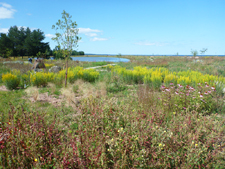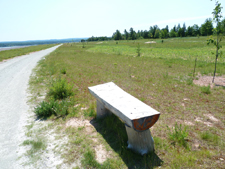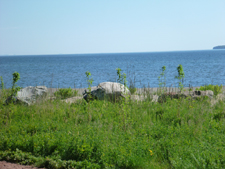Sand Point
Sand Point Brownfield Remediation & Habitat Restoration
The KBIC Natural Resource Department secured Great Lakes Restoration  funds ($360,960) to complete restoration of a 33.6 acre brownfield site on an area called Sand Point that protects coastal wetlands and is located in Baraga, Michigan. Sand Point is culturally important for KBIC as it is the site of the Pow Wow grounds, a traditional healing clinic, wild rice beds, and campgrounds. Historically Sand Point was used by the native people for hundreds of years as indicated by the existence of ancient burial grounds to the east and south of the campgrounds.
funds ($360,960) to complete restoration of a 33.6 acre brownfield site on an area called Sand Point that protects coastal wetlands and is located in Baraga, Michigan. Sand Point is culturally important for KBIC as it is the site of the Pow Wow grounds, a traditional healing clinic, wild rice beds, and campgrounds. Historically Sand Point was used by the native people for hundreds of years as indicated by the existence of ancient burial grounds to the east and south of the campgrounds.
 Sand Point today has great potential for additional recreational activities, yet its resources suffer from vast tonnages of industrial copper mining sands derived from an early 20th century stamp mill. From 1901-1919 the Mass Mill disposed of roughly six billion pounds of stamp sands into Lake Superior four miles north of Sand Point. In 2006, with funds from U.S. Fish and Wildlife Service and Environmental Protection Agency, KBIC began remediation of the area by installing a 6”-10” cap of sandy-loam soil across the 33.6 acres of lakeshore and seeding with a short grass mixture to protect against erosion.
Sand Point today has great potential for additional recreational activities, yet its resources suffer from vast tonnages of industrial copper mining sands derived from an early 20th century stamp mill. From 1901-1919 the Mass Mill disposed of roughly six billion pounds of stamp sands into Lake Superior four miles north of Sand Point. In 2006, with funds from U.S. Fish and Wildlife Service and Environmental Protection Agency, KBIC began remediation of the area by installing a 6”-10” cap of sandy-loam soil across the 33.6 acres of lakeshore and seeding with a short grass mixture to protect against erosion.
 Project goals in progress include: 1) introduce a diversity of native wildlife food plants to the remediated capped sands to increase habitat for birds and other wildlife, and 2) create relief in the topography of the landscape to lessen erosion potential and protect valuable coastal wetlands.
Project goals in progress include: 1) introduce a diversity of native wildlife food plants to the remediated capped sands to increase habitat for birds and other wildlife, and 2) create relief in the topography of the landscape to lessen erosion potential and protect valuable coastal wetlands.
Soil mounds (56 total) were installed across the 33.6 acre area and native seed mixtures including twenty-nine different species have been planted. A garden area has also been installed with native plants transplanted from the KBIC Natural Resource Department greenhouse. This one-acre garden has been designed as a plot for community education as well as providing improved habitat for birds and butterflies. Restoration initiatives on Sand Point will ensure the soil cap is protected from wind and water erosion and that the area will continue to provide the next seven generations with a place of beauty and bounty. Fifteen species of trees and shrubs were planted (320/acre) in spring 2012 and approximately 150 large boulders were placed (5/acre) in autumn 2012.
 In 2010, a Tribal green house was built as part of The Zaagkii Project, a cooperative pollinator project with The US Forest Service and The Cedar Tree Institute. Plants grown in the KBIC green house are used for planting at the Sand Point Restoration Site and other locations throughout the Reservation. In 2011 close to 30 species were grown and additional seed was collected in summer and fall for 2012 propagation. Twenty five species were grown in the green house in winter/spring 2012 for planting at Sand Point.
In 2010, a Tribal green house was built as part of The Zaagkii Project, a cooperative pollinator project with The US Forest Service and The Cedar Tree Institute. Plants grown in the KBIC green house are used for planting at the Sand Point Restoration Site and other locations throughout the Reservation. In 2011 close to 30 species were grown and additional seed was collected in summer and fall for 2012 propagation. Twenty five species were grown in the green house in winter/spring 2012 for planting at Sand Point.
Brochure
Sand Point Wildlife Habitat Restoration Final Report
Sand Point Stamp Sand Beach Map
